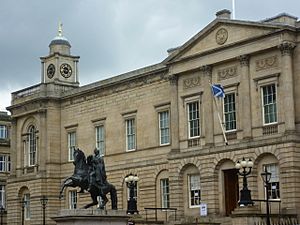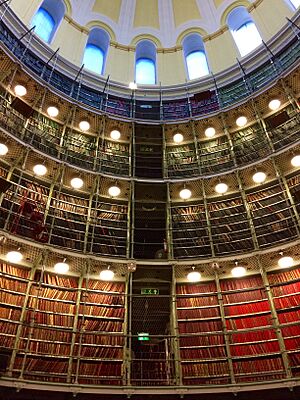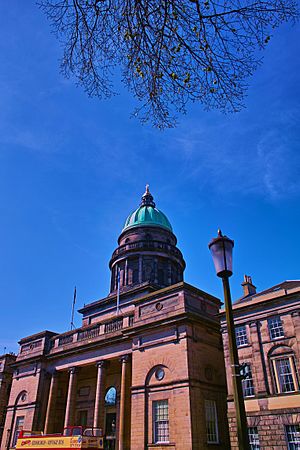National Archives of Scotland facts for kids
The National Archives of Scotland (NAS) was the name for Scotland's main collection of historical records. It was based in Edinburgh. Today, it's part of the National Records of Scotland (NRS). The NAS had one of the most varied collections of archives in Europe. It holds important documents about the history of Scotland as an independent country. It also shows Scotland's role in the British Isles and its connections with other countries over many centuries.
The NAS used to be called the Scottish Record Office. It changed its name on January 7, 1999. It was a special part of the Scottish Government. The person in charge was called the Keeper of the Records of Scotland. This agency helped the Scottish Minister for Culture. Its history goes back to the 1200s!
The NAS was in charge of choosing, keeping safe, and sharing Scotland's national archives. It also helped manage records in general.
The National Archives of Scotland had three locations in Edinburgh. These included HM General Register House and New Register House in the city centre. These places were open to the public. West Register House was also in the city centre. The main storage place was Thomas Thomson House in the Sighthill area. This building also had a special department for fixing old documents. Anyone could visit to look at the archives.
On April 1, 2011, the NAS joined with the General Register Office for Scotland. They formed the National Records of Scotland. But people still sometimes use "National Archives of Scotland" to talk about the old records themselves.
Contents
A Look Back: History of Scotland's Archives
Early Days and Lost Records
The story of Scotland's national archives is a bit like Scotland's own history – sometimes tough. Many records were lost because they were taken out of the country. This happened first in the 1200s by Edward I during the Wars of Independence. Later, Oliver Cromwell took more records in the 1600s.
Because of these losses, the oldest public record we still have is from 1189. It's called the Quitclaim of Canterbury. The oldest private record is a special paper from David I in 1127. Full records of the Scottish Parliament only start from 1466. The first person in charge of records was mentioned in 1286. This job later became the Lord Clerk Register.
Archives in the Middle Ages
When war started between Scotland and England in 1296, Edward I invaded. He took away all the important Scottish symbols. This included the royal treasures, the national archives, and the Stone of Destiny. They were all moved to London.
The Treaty of Edinburgh–Northampton ended the first war in 1329. It said the records should go back to Scotland. But they stayed in London, and many disappeared. When the remaining ones finally came back in 1948, only about 200 documents were left. During the time of Robert I (1306–1329), more records were collected. By the mid-1500s, a special "register house" was built in Edinburgh Castle to keep them safe.
Civil War and Cromwell's Impact
The archives were safe in Edinburgh Castle until Cromwell's army captured it in December 1650. The Scots were allowed to move the archives to Stirling Castle. But when Stirling Castle also fell to the English in August 1651, some records were lost. Most were sent away to London.
Moving them was very inconvenient. So, in 1657, some legal records were sent back to Scotland. It wasn't until Charles II became king again in 1660 that the other records were returned. Sadly, one of the two ships carrying the archives, the 'Elizabeth', sank in a storm. All the papers and parchments on board were lost.
The Laigh Hall: A Damp Home
The records that survived the journey north were put back in Edinburgh Castle. But in 1662, the legal records moved to the Laigh Hall. This was a space below the Parliament Hall in Edinburgh. Other records from the Castle joined them in 1689.
This move was meant to make the records easier to access. But the space was not good. The archives were damaged by dampness and pests. Records were piled on the floor, and water ran down the backs of cupboards. A big fire in 1700 threatened the Parliament House. This forced a quick move of the records to St Giles' church for safety. Even though the Treaty of Union in 1707 said the records should stay in Scotland forever, there was no money to build a proper home for them.
General Register House: A Grand New Home
By the mid-1700s, everyone agreed that the national archives needed a proper building. In 1765, £12,000 was given to build a "proper repository." This money came from the properties of people who had rebelled in the Jacobite rising of 1745. A spot was chosen at the end of the North Bridge, which was being built then.
The famous architect Robert Adam and his brother James were chosen for the project in 1772. The first stone was laid in 1774. Robert Adam used local stone and workers. The building was just an empty shell when work stopped in 1779. It was called "the most magnificent pigeon-house in Europe" and was a place for thieves.
Building started again in 1785. General Register House was finished in 1788. Robert Reid later finished the outside and designed the inside in the 1820s. He also designed the room where people could search for historical records. General Register House is one of the oldest buildings in the world built specifically for archives that is still used today.
Thomas Thomson: Modernizing the Archives
In 1806, a new job was created to manage the daily work of the archives. Thomas Thomson got this job. His appointment helped create the modern record office we know today. For 35 years, he worked on cataloguing and repairing old records. He also started publishing series of records.
West Register House: Expanding Space
Since the early 1900s, the number and types of records kept grew a lot. The office needed more space and better facilities. In 1971, the old St George's Church in Charlotte Square was turned into West Register House.
Robert Adam, who designed General Register House, had also designed the front of the houses in Charlotte Square. He even had a plan for a church there. But a different design was used, and the church opened in 1814. The church found a serious problem with wood rot in 1959. They couldn't afford the repairs, so it closed in 1961. In 1968, the church began to be changed into a branch of the Scottish Record Office. The outside stayed the same, but the inside was completely changed. Five floors were added for offices and record storage.
Thomas Thomson House: A Modern Storage Solution
By the 1980s, both city centre locations were full. It was clear another building was needed. This was a chance to design a truly modern archive building. In 1994, Thomas Thomson House was built in the Sighthill area of Edinburgh. The Princess Royal opened it the next year.
This building was designed to hold the National Archives of Scotland until the mid-2000s. It's like two separate buildings joined together. One part has over 37 kilometres of storage space. This space has special controls for temperature and humidity to protect the records. The other part has areas for receiving and sorting records, offices, a special conservation unit, and digital imaging facilities.
What's Inside: Collections and How to Access Them
The National Archives of Scotland holds records from old parchment scrolls to modern digital files and archived websites. One very famous document kept here is the Declaration of Arbroath.
You can search for the materials in the NAS On-Line Catalogue. You can also see them for free in person at the NAS search rooms. You just need to apply for a reader pass. Sometimes, you can access them in other ways, like by mail.
Here are some types of records you can find:
- Government Records: Papers from the Scottish crown, parliament, and government before 1707. Also, records from the Scottish Office and Scottish Government after 1886.
- Legal Records: Registers of deeds and property sales. Records from the Court of Session, the High Court of Justiciary, and local sheriff courts (including adoption records). The NAS provides thousands of copies from legal registers each year.
- Church Records: Records for the Church of Scotland, Free Church of Scotland, and other churches. Also, copies of baptism, marriage, and burial records for Roman Catholics before 1855.
- National Industries and Transport: Records of Scottish railways, canals, coal, gas, electricity, steel, and shipbuilding industries.
- Local Administration: Valuation rolls for all Scottish counties and towns from 1855 to 1995. Also, records from some towns, county councils, and other local authorities.
- Private Collections: Papers from families, lawyers, and estates. Also, records from businesses, societies, and other groups.
- Maps and Plans: Maps, plans, and drawings from government departments, industries, transport systems, courts, churches, and private groups.
Other Ways the Archives Help
Besides choosing, keeping safe, and sharing Scotland's national archives, the NAS does other things. It helps with education, providing resources for teachers and schools. This makes sure the archives are useful to Scottish society. For example, they had an exhibition at the Scottish Parliament about the Act of Union.
The NAS also gives advice to Scottish Ministers about records and information. It helps public authorities in Scotland manage their records. It also advises private owners about their historical records. It provides a service to the public for all questions about the national archives. It also leads the way in developing how records are managed in Scotland.
Scottish Archive Network (SCAN): Going Digital
In the late 1990s, the NAS became a leader in putting historical records online. This was part of the Scottish Archive Network (SCAN) project. SCAN worked with the Heritage Lottery Fund and Family Search.
The SCAN project created one big online catalogue for the records of more than 50 Scottish archives. It also started a program to copy documents using high-quality digital cameras.
SCAN's biggest success was digitizing half a million wills and testaments. These were recorded between 1513 and 1901. They linked these to one easy-to-use index and made them available online. After the project finished in 2004, the NAS continued to maintain SCAN's products and websites.
New Ways to Explore: Recent Developments
Digitizing More Records
The NAS has continued to expand its digitisation program that started with SCAN. They are currently digitizing the register of sasines (Scotland's property register). They are also digitizing records from church courts. These church records include about five million pages of information! The NAS is creating an online system to access these large historical sources. This is called "virtual volumes." You can also still see them for free in the NAS's public search rooms.
ScotlandsPeople Website: Your Family History
Working with the General Register Office for Scotland (GROS), the NAS provides content for the ScotlandsPeople website. This website lets you search old church registers before 1855. You can also find official birth, marriage, and death records from 1855 onwards. Census records from 1841 to 1911 are also there. Plus, you can find the wills that SCAN digitized.
ScotlandsPeople Centre: A Hub for Genealogy
The ScotlandsPeople Centre is a great place for anyone interested in genealogy (family history). It fully opened on January 12, 2009. The Centre is located in HM General Register House and New Register House. It's a partnership between the NAS, the General Register Office for Scotland, and the Court of the Lord Lyon. This means it's a single place for all your family history research in Scotland. Unlike the National Archives, most services at the ScotlandsPeople Centre have a fee.
See also
- List of national archives
- General Register Office for Scotland
- Court of the Lord Lyon
- The National Archives
- Royal Commission on the Ancient and Historical Monuments of Scotland




